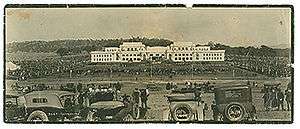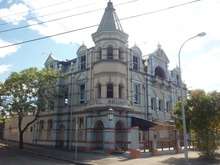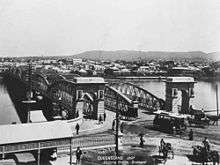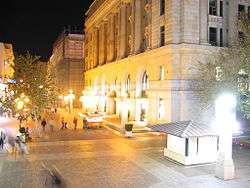John Smith Murdoch
| J.S. Murdoch – Architect | |
|---|---|
| Born |
29 September 1862 Cassieford Farm, Forres, Scotland |
| Died |
21 May 1945 Brighton, Melbourne, Australia |
| Occupation | Architect |

.jpg)
John Smith Murdoch CMG (29 September 1862 – 21 May 1945)[1] was the chief architect for the Commonwealth of Australia from 1919,[2] responsible for designing many government buildings, most notably the Provisional Parliament House in Canberra,[2][3] the home of the Parliament of Australia from 1927 to 1988.[4]
Personal life
John Smith Murdoch was born in Cassieford Farm, Forres, Scotland.[2][1][5]
He had a "dry and quiet" personality and was frugal in both his professional and private life.[6] Murdoch never married,[3] and there are only two official known photographs of him.[7]
Murdoch was a member of the Masonic order and it is claimed that he incorporated many masonic motifs into his designs.[8]
He died in Brighton, Melbourne.[3]
Professional life
Murdoch was educated at the Parish school at Rafford and at Forres Academy and received his architectural training in Scotland.[1][3] He was articled to the architectural firm Matthews and Mackenzie in 1878.[3] After completing his articles in 1883 he became assistant in the office of Alexander Ross in Inverness before moving to Glasgow to work for Campbell Douglas & Sellars and then for the Glasgow South Western Railway Engineers' Department.[3] In 1884 Murdoch emigrated with his parents to Melbourne[1] in response to the severe depression of the 1880s.[3]
In Melbourne, Murdoch was briefly employed by the architectural firm Reed, Henderson and Smart before being appointed as a draftsman in the Queensland Department of Public Works in 1885.[1][9] While working for the Public Works Department, Murdoch is said to have designed the Sandgate Post Office (1887) before being retrenched on 30 June 1887 due to a downturn in public works.[10]
Murdoch then joined the firm John Hall and Son where he was employed until 1893.[11] While working for John Hall and Son, it is claimed that Murdoch designed the South Brisbane Municipal Chambers (1890–1892), Gladstone Place and several South Brisbane hotels, including Broadway Hotel (1889–90) and Burke's Hotel (1890).[11]
In 1893, Murdoch was re-appointed to the Public Works Department where he worked until 1904.[11] During this time he worked on a great number of public buildings throughout Queensland. The design work produced by the department at this time was somewhat collaborative. Other prominent architects working for the Queensland Public Works Department who may have contributed to design work credited to Murdoch (and vice versa) include Thomas Pye and Alfred Barton Brady.[12][13]
In 1904 Murdoch transferred to the Commonwealth Department of Home Affairs in Melbourne, as a Senior Clerk.[11][14] Here he was promoted to Architect in 1914 and Chief Architect in 1919–29.[2] He was involved with the planning of Canberra and designed many significant buildings including the Provisional Parliament House, Canberra (1927), the Canberra Hotel (1922–25), the General Post Office, Perth (1923), Spencer Street Post Office and the Former High Court of Australia, Melbourne (1925).[2] He laid out Forrest Place, Perth (1923), and Anzac Square, Brisbane (1926).[2] Murdoch was promoted to Director-General of Works by 1927 and was appointed C.M.G. (Companion of the Order of St. Michael and St. George) to honour his service to the Commonwealth of Australia.[11][3] Murdoch moved to Canberra with his Department in 1929 and retired later the same year, remaining a member of the Federal Capital Commission until its abolition in 1930.[3]
Works
Queensland




List of known works in Queensland:
| 1887 | Sandgate Post Office (former): 1 Bowser Pde, Sandgate 4017[10] |
| 1888–89 | West End School of Arts (demolished): Boundary St, West End 4101[11] |
| 1889–90 | Burke's Hotel (Red Brick Hotel): 83 Annerley Rd, South Brisbane 4102[11] |
| 1890 | Broadway Hotel: 93 Logan Rd, Wooloongabba 4102[11] |
| 1890 | South Brisbane Municipal Chambers (South Brisbane Town Hall): 263 Vulture Street, West End 4101[15] |
| 1894–95 | Victoria Bridge Abutments (bridge demolished, abutments existent): Victoria Bridge, South Brisbane 4101 (with A.B. Brady)[11] |
| 1896 | Queensland Agricultural College (University of Queensland Gatton campus) (partially demolished, Foundation Building and Homestead existent): Warego Hwy, Lawes 4343[11] |
| 1897 | Central Watch-tower, Stewart's Creek Gaol (Stuart Creek Jail), Dwyer Street, Stuart 4811, Townsville[11] |
| 1897 | Charleville Court House (demolished): Alfred St, Charleville 4470[11][16] |
| 1897 | Dalby Consumptive's Hospital (Jubilee Sanatorium, Jubilee Hospital) (demolished), Dalby[11][16][17] |
| 1898–1900 | Maryborough Customs House: Richmond St, Maryborough 4650[17] |
| 1900–01 | Roma Court House: 141 McDowall Street, Roma 4455[18] |
| 1900–01 | Mackay Customs House: 31 River St, Mackay 4740[19] |
| 1900–01 | Gympie Court House, Channon Street, Gympie 4570[19] |
| 1900–01 | Stanthorpe Post Office: 14 Maryland Street, Stanthorpe 4380[19] |
| 1900–01 | Brisbane Naval Offices: 3 Edward St, Brisbane 4000[19] (with Thomas Pye?) |
| 1900–02 | Bundaberg Customs House (demolished): Quay St, Bundaberg 4670[19] |
| 1903 | Boggo Road Gaol: No. 2 Division: 150 Annerley Rd, Dutton Park 4102[20] |
| 1903–04 | St. Luke's Mission Hall (The Pancake Manor): 10 Charlotte St, Brisbane 4000[11] |
| 1903–04 | St. John's School and Institute (Webber House): 439 Ann St, Brisbane 4000 (with Robin Dodds)[11] |
| 1926 | ANZAC Square, Brisbane: 228 Adelaide Street, Brisbane 4000[11] |
| 1932–59 | Former Queensland Government Offices: 255A Ann St, Brisbane 4000[21] |
| 1933–36 | Commonwealth Government Offices: 232 Adelaide St, Brisbane 4000[22] |
Victoria
Notable Melbourne works include:
- Commonwealth Offices, Treasury Place (1912)[23]
- former Mail Exchange, Bourke Street (1913)[24]
- former High Court, Little Bourke Street (1926).[25]
Western Australia
Notable Western Australian works include:
- the Commonwealth Bank and General Post Office buildings (1923)[26] in Forrest Place, Perth designed in association with William Hardwick who at the time was Principal Architect (Western Australia).
Canberra
Murdoch persuaded Walter Burley Griffin to come to Australia from the USA, and who went to Sydney to greet him on his arrival in 1913.[27] Later, however, he had a difficult relationship with Griffin.[28]
Murdoch designed the Provisional Parliament House in Canberra.[2] However, he had no enthusiasm for the project, saying expenditure on it could not be justified at the time; and he thought the whole idea was a waste of money.[29]
Murdoch also designed many of Canberra's first public buildings, such as:
- Kingston Power Station (1913–1915). This was decommissioned in the early 1960s, and reopened on 25 May 2007 as Canberra Glassworks, a glass artist studio.[30]
- the Hotel Canberra (Hostel No. 1) (1924) – now the Hyatt Hotel[31]
- the Hotel Kurrajong (Hostel No. 2) (1926)[32]
- Secretariat Buildings No. 1 and 2 (1927) – now East and West Blocks[33][34]
- Gorman House (Hostel No. 3) (1924–25)[35]
- Ainslie Public School (1936)[36]
- several residential hotels necessary for public servants and politicians.
New South Wales
- 12 bungalows for staff of the Royal Australian Navy College (1915), HMAS Creswell, Jervis Bay, New South Wales. The bungalows are now heritage-listed, and were refurbished in 2006–07.[37]
Gallery of work
 Dalby Consumptive's Hospital, Dalby, 1897
Dalby Consumptive's Hospital, Dalby, 1897 Maryborough Customs House, Maryborough, 1900
Maryborough Customs House, Maryborough, 1900 Mackay Customs House, Mackay, 1900–01
Mackay Customs House, Mackay, 1900–01 Brisbane Naval Offices, 1901
Brisbane Naval Offices, 1901 Boggo Road Gaol, No. 2 Division, Dutton Park, Brisbane, 1903
Boggo Road Gaol, No. 2 Division, Dutton Park, Brisbane, 1903 St. Johns' School and Institute, Brisbane, 1903–04
St. Johns' School and Institute, Brisbane, 1903–04 Commonwealth Government Offices, Treasury Place, Melbourne, 1912
Commonwealth Government Offices, Treasury Place, Melbourne, 1912 Former mail exchange, Melbourne, 1913–17
Former mail exchange, Melbourne, 1913–17 Provisional Parliament House, Canberra, 1922
Provisional Parliament House, Canberra, 1922 GPO, Forrest Place, Perth, 1923
GPO, Forrest Place, Perth, 1923 Commonwealth Bank Building, Forrest Place, Perth, 1923
Commonwealth Bank Building, Forrest Place, Perth, 1923- Hotel Canberra, 1924
 East Block, Canberra, 1925–56
East Block, Canberra, 1925–56 ANZAC Square, Brisbane, 1926
ANZAC Square, Brisbane, 1926 Former Queensland Government Offices, Brisbane, 1931–59
Former Queensland Government Offices, Brisbane, 1931–59 Commonwealth Government Offices, Brisbane, 1933–36
Commonwealth Government Offices, Brisbane, 1933–36
See also
References
- 1 2 3 4 5 Rowe (1995), p. 36
- 1 2 3 4 5 6 7 D. I. MacDonald. "Murdoch, John Smith (1862–1945)". Australian Dictionary of Biography.
- 1 2 3 4 5 6 7 8 9 "John Smith Murdoch", Dictionary of Scottish Architects 1840–1980.
- ↑ "A Short History of Parliament", Parliamentary Education Office, Commonwealth Parliament of Australia http://www.peo.gov.au/students/cl/shorthistory_first-parliament.html
- ↑ CP 965: John Smith MURDOCH CMG, National Archives of Australia, retrieved 18 April 2014
- ↑ Rowe (1997), p. 1
- ↑ Rowe (1997), p. 2
- ↑ Denis Strangman, "John Smith Murdoch, Brisbane, a Wooden Leg, Symbolic Signs, and the OPH Building", accessed 31 May 2007, http://web.archive.org/web/20060904020357/http://www.geocities.com/string_au/murdoch.htm
- ↑ Watson & McKay (1994), p. 127
- 1 2 Watson & McKay (1994), pp. 127–128
- 1 2 3 4 5 6 7 8 9 10 11 12 13 14 15 16 Watson & McKay (1994), p. 128
- ↑ "Customs House", Australian Heritage Places Inventory, http://www.heritage.gov.au/cgi-bin/ahpi/record.pl?RNE8899
- ↑ "Customs House and Residence (former)", Australian Heritage Places Inventory, http://www.heritage.gov.au/cgi-bin/ahpi/record.pl?RNE8769
- ↑ Rowe (1995), p. 25
- ↑ South Brisbane Municipal Building, The Brisbane Courier, 6 June 1892, http://nla.gov.au/nla.news-article3542993
- 1 2 Stuart King, "Queensland Public Buildings 1870 – 1904: Eclecticism and Composition", Cultural Crossroads: Proceedings of the 26th International SAHANZ Conference, 2 – 5 July 2009, University of Auckland, New Zealand, 540–555. ISBN 978-0-473-15065-5 (2009)
- 1 2 "The Diamond Jubilee; The Proposal of the Government; Consumptive Hospital at Dalby", The Brisbane Courier (Wednesday 19 May 1897), http://nla.gov.au/nla.news-article3651178?searchTerm=dalby%20jubilee%20hospital&searchLimits=
- ↑ "Roma Court House and Police Buildings (entry 601285)". Queensland Heritage Register. Queensland Heritage Council. Retrieved 12 August 2015.
- 1 2 3 4 5 Watson & McKay (1994), p. 129
- ↑ "Boggo Road Gaol: No 2 Division and Remnant No 1 Division", Australian Heritage Places Inventory, http://www.heritage.gov.au/cgi-bin/ahpi/record.pl?QLD601033
- ↑ "Former Queensland Government Offices (Anzac Square Building)", Australian Heritage Places Inventory, http://www.heritage.gov.au/cgi-bin/ahpi/record.pl?QLD600059
- ↑ "Commonwealth Government Offices", Australian Heritage Places Inventory, http://www.heritage.gov.au/cgi-bin/ahpi/record.pl?QLD600064
- ↑ "Commonwealth Offices", Heritage Victoria, http://vhd.heritage.vic.gov.au/vhd/heritagevic#detail_places;65745
- ↑ "Former Mail Exchange", Heritage Victoria, http://vhd.heritage.vic.gov.au/places/result_detail/709?print=true
- ↑ "High Court of Australia (former)", Australian Heritage Database, http://www.environment.gov.au/heritage/ahc/national-assessments/high-court/pubs/high-court.pdf
- ↑ "Perth General Post Office", Australian Heritage Places Inventory, http://www.heritage.gov.au/cgi-bin/ahpi/record.pl?CHL105527
- ↑ Rowe (1995), p. 29
- ↑ Max Bourke, "Old house rules", in Canberra 1900–2000 (supplement to the Canberra Times), 19 March 2000.
- ↑ Robert Messenger, "'Mythical thing' to an iced reality", in Old Parliament House: 75 Years of History (supplement to the Canberra Times), 4 May 2002.
- ↑ "In the Engine Room", Canberra Glassworks, http://www.canberraglassworks.com/live-glassmaking/in-the-engine-room/
- ↑ ACT Government, "Hotel Canberra", Libraries ACT, http://www.library.act.gov.au/find/history/frequentlyaskedquestions/Place_Stories/hotelcanberra
- ↑ "Hotel Kurrajong and Setting", Australian Heritage Places Inventory, http://www.heritage.gov.au/cgi-bin/ahpi/record.pl?RNE18152
- ↑ "East Block Government Offices", Australian Heritage Places Inventory, http://www.heritage.gov.au/cgi-bin/ahpi/record.pl?RNE19963
- ↑ "West Block and the Dugout", Australian Heritage Places Inventory, http://www.heritage.gov.au/cgi-bin/ahpi/record.pl?CHL105428
- ↑ "Gorman House", National Trust Register Of Significant Places, http://www.m2cms.com.au/uploaded/18/ClassifiedPlaces/GORMAN%20HOUSE%20CITATION.pdf
- ↑ "Ainslie Public And Primary Schools, Braddon", Interim Heritage Places Register, http://www.m2cms.com.au/uploaded/18/ClassifiedPlaces/AINSLIE%20PUBLIC%20&%20PRIMARY%20SCHOOLS.pdf
- ↑ "Creswell's heritage houses restored" Navy News 50, no.9, 31 May (2007): 6.
Bibliography
- Rowe, David (1995). "John Smith Murdoch and the early development of Canberra". Fabrications. 6: 24–37.
- Rowe, David (1997). Building a national image: the architecture of John Smith Murdoch, Australia's first Commonwealth Government architect (PhD thesis). Deakin University.
- Watson, Donald; McKay, Judith (1994). Queensland Architects of the 19th Century: a Biographical Dictionary. Brisbane: Queensland Museum. ISBN 0724256571.
External links
| Wikimedia Commons has media related to John Smith Murdoch. |
- Timeline of life and works of John Smith Murdoch, Thomas Pye and George David Payne in Brisbane
- Google Maps of Brisbane works of John Smith Murdoch
- Google Maps of Queensland works of John Smith Murdoch
- "IN THE PUBLIC EYE.". The Canberra Times (ACT : 1926 – 1954). ACT: National Library of Australia. 17 May 1927. p. 4. Retrieved 7 October 2012. Photograph of John Smith Murdoch
- Canberra Glassworks
- Pillars of A Nation; John Smith Murdoch
- National Heritage List Nomination for Old Parliament House and Curtilage
- Dictionary of Scottish Architects; John Smith Murdoch
- Australian Dictionary of Biography; Murdoch, John Smith (1862–1945)
- National Archives of Australia; East Block building, Canberra – Fact Sheet 174
- Australian Heritage Places Inventory
- Queensland Heritage Registry